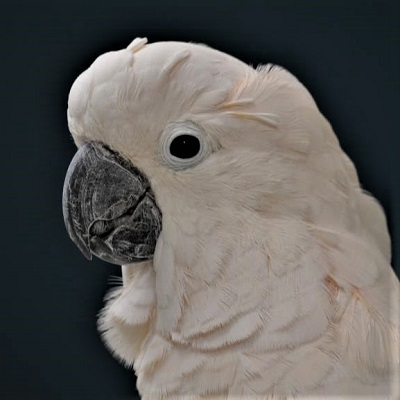
The Moluccan cockatoo wants to get a headstart on the August long weekend, so we need to say good-bye to him as our Animal of the Month for July. We hope you enjoyed following us on Twitter @ExoticPetVets as we tweeted all month long about these highly intelligent and emotional birds. But in case you missed any of our tweets, here is a summary you can reference anytime. Did you know?:
- The Moluccan cockatoo (Cacatua moluccensis) is a large parrot species endemic to Indonesia’s south Molucca (or Maluku) islands. This species is also known as the salmon-crested cockatoo.
- In the wild, Moluccan cockatoos are mostly found in lowland dense old-growth, or primary, forests. They don’t live at elevations higher than 1,000-metres above sea level.
- It’s difficult to say exactly how many Moluccan cockatoos are alive in the wild. The IUCN Red List offers a wide estimate ranging from a low of 6,600 to a possible high of 67,000.
- What is known is that the Moluccan cockatoo is a vulnerable species and the wild population is decreasing.
- The biggest threat to wild Moluccan cockatoos is trapping for the pet trade. The IUCN Red List says while international trade stopped in the 1990’s, it’s estimated that 4,000 are trapped per year for domestic trade.
- Habitat loss due to human settlement, agriculture, hydro-electric projects and logging is also a significant threat to Moluccan cockatoos in the wild.
- In the wild, Moluccan cockatoos spend their days foraging for seeds, nuts and fruits. They will also eat insects and insect larvae.
- Wild Moluccan cockatoos are also considered to be an agricultural pest because they will feast on grain crops. They are particularly destructive in coconut plantations.
- Their large black beaks are able to exert 500 pounds of pressure so cracking a coconut to reach the milk and pulp inside is a not a problem for Moluccan cockatoos.
- Of the white cockatoo species, Moluccan cockatoos are the largest. When fully grown, their total body length (including tail) measures over 50 cms (20 inches).
- Female Moluccan cockatoos are larger than their male counterparts. Females also have brown or reddish-brown eyes while the males have black or dark brown eyes.
- Moluccan cockatoo plumage is mostly white with a peachy pink-coloured hue. The feathers on the undersides of their wings and tail feathers are a pale yellow.
- Moluccan cockatoos have a large recumbent crest on their heads. When they raise their crests the feathers on the underside are revealed, showing their brilliant orange-red colour.
- The large recumbent crest is not only a defining physical characteristic of the Moluccan cockatoo, but it is also a key tool for non-verbal communication.
- When a Moluccan cockatoo raises his crest, it could have a variety of meanings; including – but not limited to – fear, surprise, excitement, frustration or curiosity.
- A raised crest could also mean a Moluccan cockatoo is displaying for his mate, defending his territory, threatening predators or warning people not to touch him.
- When his crest is lowered, it can mean the Moluccan cockatoo is calm, approachable, open and friendly.
- We may all scream for ice cream – as the old song goes – but Moluccan cockatoos will scream for seemingly any reason at all. In the wild, screaming is a means of communication for them.
- In captivity, Moluccan cockatoos will scream at any time of day without apparent reason. If they’re happy, they scream. If they’re upset, they scream. If they’re bored, they scream, etc.
- Even though Moluccan cockatoos are not well-known for mimicking sounds and human speech, they do have some ability in this area.
- For example, Sydney is a Moluccan cockatoo at the Monterey Zoo in California. He can mimic the sounds of a police scanner because when he was in his previous home he was placed next to a police scanner.
- Moluccan cockatoos are very intelligent, emotional and sensitive birds. They enthusiastically want to give their human family members love and affection – but they also need love in return.
- Moluccan cockatoos in captivity need lots of daily attention from their human family members and mental stimulation as neglect and boredom can lead to serious behavioural problems, such as self-mutilation.
- Their constant need for attention, combined with their screaming, gives Moluccan cockatoos the unfortunate distinction of being among the most neglected, abandoned and abused birds in captivity.
- Moluccan cockatoos are a long-lived species and, in captivity, can live to an average of 70 years with proper care.
- A 2012 research paper titled “Survival on the ark: Life-history trends in captive parrots” examined 83,212 life history records of captive parrots and found the oldest parrot of all the birds in the study was a 92-year-old Moluccan cockatoo!

